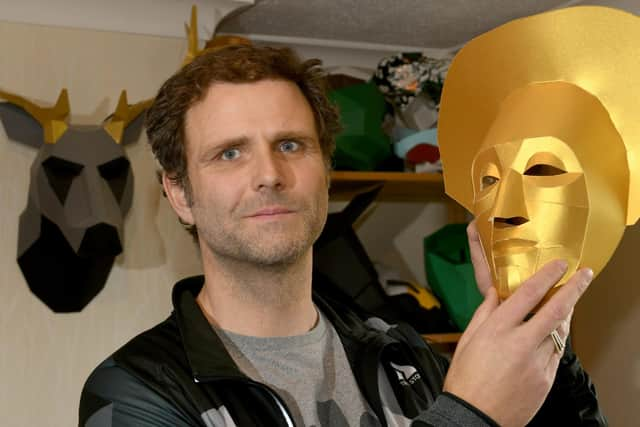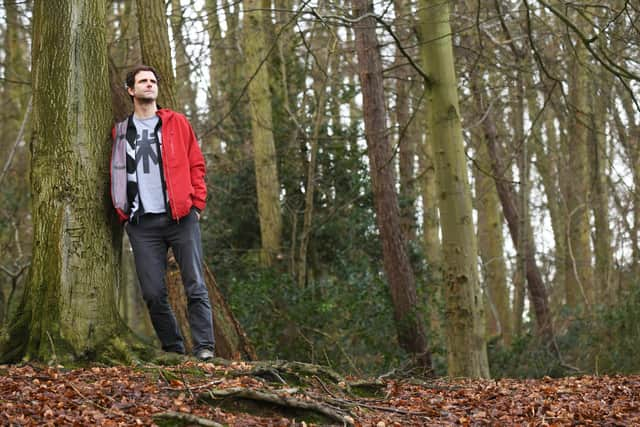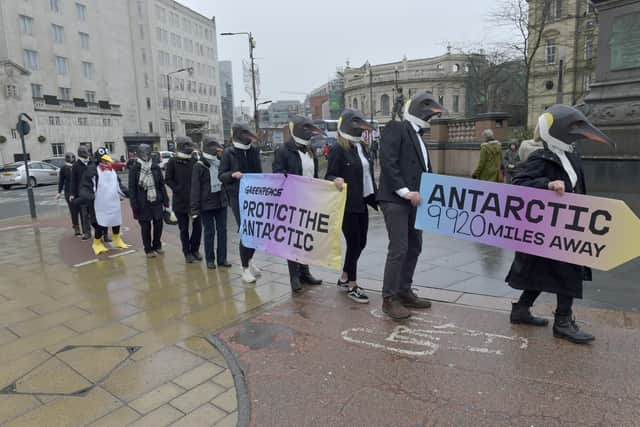How Scarborough mask-maker Wintercroft caught the eye of Greenpeace, Björk and the BBC Proms
The ‘penguins’ huddled outside London’s National Theatre, in the deserts of Israel, at the shores of the Dead Sea, below Tokyo skyscrapers and skated on ice in Stockholm.
An army of around 3,500 humans wearing penguin masks waddled along streets in 41 countries on one day in 2018 as part of a Greenpeace campaign to raise awareness about the plight of penguins and the campaign to protect the Antarctic.
Advertisement
Hide AdAdvertisement
Hide AdThe masks were designed by Steve Wintercroft, a Scarborough artist who uses sustainable methods to help a community of people across the globe enjoy creativity.


Wintercroft says: “They did a campaign where they got people dressed as penguins in a whole bunch of cities all over the world.
“And so with a digital template, we were able to send it out to all these different people. It was printed locally, and then the masks were put together in situ, and then we had people marching all over the world as penguins on the same day, which is amazing. The visual impact is very strong. It’s a good way of getting a strong message across.”
Wintercroft and his wife Marianne’s model of offering mask templates to anyone who wants to download them online has been going for years.
Advertisement
Hide AdAdvertisement
Hide AdBut that day of campaigning was just one high-profile project among many for Wintercroft, which is the name of their trademark and a moniker which has caught the attention of artists such as Björk.


Its origins, though, were hurried and humble.
“I got an invite to a Halloween party,” says Wintercroft. “I was living in Cornwall, the Halloween party was up near York. It was a bit of a last minute thing – I didn’t have any costume sorted out so I just sort of raided the recycling bin and put together a fox mask out of just waste card.
“I turned up to this party and everyone loved it. And I figured, it’d be really nice to be able to help other people do the same sort of thing.
“So we developed a process that enables other people to make masks out of waste material. And from there, we’ve just been doing that in sort of a very open, collaborative way.”


Advertisement
Hide AdAdvertisement
Hide AdThe beauty is that anyone, anywhere can do it with materials around them.
“It’s a very democratising process. The barriers to it are very low. And you can make the most out of whatever materials you’ve got.
“We encourage people to make them out of just whatever they can collect – cereal boxes are great, packaging, anything like that. I see them as a starting point – we provide the framework for people to create on top of, so most people who build our masks end up painting them and decorating them and then from there, they get used for all sorts of stuff – music videos, films, theatre, all sorts.”
Many of the masks are created using a process called papercraft to become flat-edged, 3D sculptural versions of various animals.
Advertisement
Hide AdAdvertisement
Hide AdWintercroft’s ideas were used by Aurora Orchestra during their live broadcast of Berlioz’s Symphonie fantastique: The Witches’ Sabbath at the BBC Proms in 2019.
He also adapted James Merry’s “moth mask” created for Björk, which was given as a press-out version in the musician’s limited edition Vulnicura Live luxury box set.
Elsewhere, he collaborated with the people behind HBO television phenomenon Game of Thrones to create a 3D mask books.
Those are just a few examples of notable uses of his masks, and the proliferation of digital technologies has allowed the concept to flourish.
Advertisement
Hide AdAdvertisement
Hide AdWintercroft says: “The best bit about is this sort of community and collaboration that’s grown with it, that we’ve got people all over the world building masks that we work with.
“It’s something that wouldn’t have been possible maybe 10 years earlier – the digital connection with people that (means) you don’t need to be in the same place to work with them. We’ve met some incredible people through it and we’ve just been very lucky.”
He is involved with local art projects, too, and in the run-up to Christmas collaborated with Yorkshire Coast BID, arts charity ARCADE and students from Scarborough Sixth Form to build a festive installation made entirely out of recycled and repurposed materials.
It aimed to show “what is possible with a bit of imagination and old cardboard”, inspiring people to think differently about packaging and waste during the Christmas period.
Advertisement
Hide AdAdvertisement
Hide AdThis passion for creativity was one Wintercroft first found in his childhood on the Yorkshire coast.
“I’ve always made stuff ever since I was a kid. I’ve got a compulsion to make things. I find it therapeutic and relaxing, and it ticks lots of boxes for me. It’s kind of what I do.
“I originally trained as a cabinet maker, I was building kitchens for a company in York for a while. Around the same sort of time I also taught myself to shape surfboards.”
In 1998, he founded Fluid Concept in Scarborough with his friend Mark Dickinson (this was passed on to others and still runs at the Spa complex in the North Yorkshire town).
Advertisement
Hide AdAdvertisement
Hide AdBut he says: “I grew up in Scarborough in a time when if you wanted to do anything creative, it was very difficult to do that. There weren’t many creative opportunities in the town. So if you wanted a creative job you had to either make one yourself or go leave the town to go find one.”
After being offered a job he moved to Cornwall to work for the Laminations surfboard factory in 2004.
Later, a back injury was making it difficult for him to operate machinery and, becoming more environmentally conscious, he wasn’t comfortable working in an industry which, despite efforts to become cleaner, uses petrochemicals.
“We’re surfers, we spend all our time in the sea,” he says. “I’m generalising, but on the whole, we’re very in tune with the places where we surf.”
Advertisement
Hide AdAdvertisement
Hide AdIt was in 2013 that he and Marianne founded Wintercroft as an environmentally conscious design company, which is now run with Marianne and one “invaluable” employee, Fletcher Stewart.
The couple returned to Scarborough in 2016, finding the sort of thriving arts community Wintercroft had longed for during his formative years in the seaside town.
“Scarborough’s a strange place,” he says. “It’s beautiful and it’s the most incredible location, but I think it’s largely undervalued and underappreciated.
“But there there’s a really energetic, vibrant creative community. It was here when I came back, and it’s growing every year, which is just fantastic.
Advertisement
Hide AdAdvertisement
Hide Ad“It feels like there’s more energy in the place now than at any time when I’ve been here in the past. One of the reasons we originally left was it was difficult to find creative work here, but it’s starting to feel like that’s changing.”
To download Wintercroft templates, visit wintercroft.com.